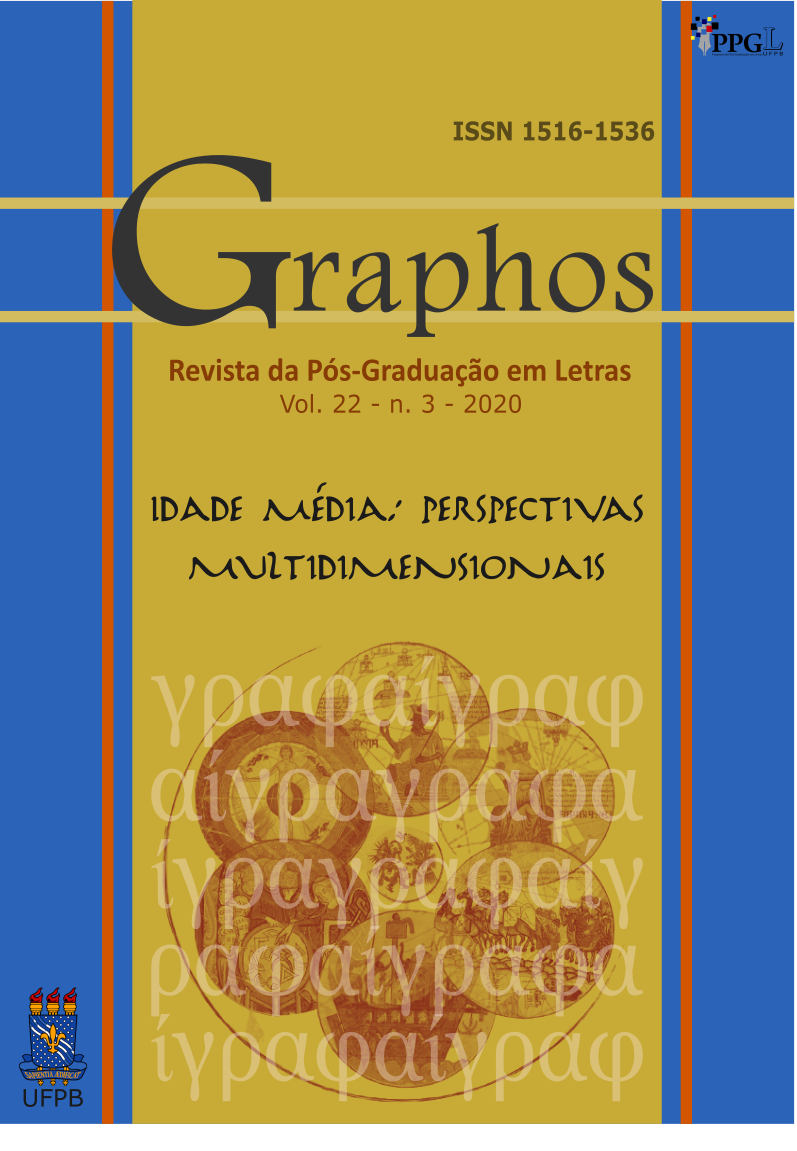From Eve to the ladies of Christine de Pizan: deconstructing the image of women in the Middle Ages
DOI:
https://doi.org/10.22478/ufpb.1516-1536.2020v22n3.52676Keywords:
Medieval Literature, Woman, Image, Deconstruction, Christine de PizanAbstract
The unidirectional tendency of traditional historiography in the treatment of its objects of study leads to a certain impossibility in the investigation of gender relations in medieval studies, mainly in its articulation with the literary. The systemic orientation of this historiographical model, based on prerogatives of the so-called gender coloniality with its unrivaled androcentric worldview, has always been constituted of mental and rhetorical formations built and perpetuated by the strength of its origin and tradition. Intending to investigate/deconstruct some aspects of the construction of the feminine reality within the scope of ideological and politically presented configurations in the Middle Ages, named “long” by Jacques Le Goff (2008), this paper examines the issue of becoming woman in authors and works of the Middle Ages. To this end, it proceeds to a significant anthological rescue of medieval texts of fundamental importance for the treatment of this complex and controversial subject of medieval history and culture. In the course of this critical-deconstructive examination, covering the range from Eve to the ladies of Christine de Pizan's Le Livre de la Cité des Dames, the study analyzes some of the traces and foundations of the medieval misogyny in its relationship with Howard Bloch's romantic love, one of most interesting phenomena in the history of Western thought and culture.
Downloads
References
ABELARD. Letter 6. In: _____. The Letters of Abelard and Heloise. Tradução de C. K. S. Moncrieff. Nova York: Cooper Square Publishers, 1974, p. 129-175.
ALBERTANO OF BRESCIA. Albertani Brixiensis Liber consolationis et consilii. Editado por Thor Sundby. Londres: [s.n.], 1873.
AMBROSE, St. 1961. Hexameron, Paradise, and Cain and Abel. Tradução de J. J. Savage. Nova York: Fathers of the Church, 1961.
AMBROSE, St. De Paradiso. In: _____. Opera. Editado por C. Schenkl. Viena: [s.n.], 1896.
ARISTOTLE. Aristotle: Generation of Animals. Tradução de A. L. Peck. Londres: Heinemann; Cambridge, MA: Harvard University Press, 1963.
AUGUSTINE, St. St Augustine: The Literal Meaning of Genesis (De Genesi ad litteram). Tradução de J. H. Taylor, S. J. Nova York; Ramsey, NJ: Newman Press, 1982.
AUGUSTINE, St. The Trinity. Tradução de S. McKenna. Washington, DC: Catholic University Press of America, 1963.
BEAUVOIR, Simone de. O segundo sexo: mitos e fatos. Tradução de Sérgio Millet. v. 1. Rio de Janeiro: Nova Fronteira, 1980.
BLOCH, R. Howard. Medieval Misogyny. Representations, Berkeley, n. 20, p. 1-24, 1987.
BLOCH, R. Howard. Misoginia medieval e a invenção do amor romântico ocidental. Tradução de Claudia Moraes. Rio de Janeiro: Edições 34, 1995.
BOCCACCIO, Giovanni. Concerning Famous Women. Tradução de G. A. Guarino. Londres: Allen & Unwin, 1964.
BOCCACCIO, Giovanni. The Corbaccio. Tradução de A. K. Cassel. Urbana, Chicago; Londres: University of Illinois Press, 1975.
BORRESEN, Kari. Subordination and Equivalence: The Nature and Role of Women in Augustine and Thomas Aquinas. Tradução de C. H. Talbot. Washington, DC: Catholic University Press of America, 1981.
CHAUCER, Geoffrey. The Canterbury Tales. Tradução de D. Wright. Oxford: Oxford University Press, 1985.
D’ALVERNY, Marie-Thérèse. Comment les théologiens et les philosophes voient la femme. Cahiers de civilisation médiévale, Poitiers, n. 20, p. 105-129, 1977.
DIVES and Pauper. Editado por P. Barnum. EETS, 2280, v. I. p. 2. Oxford: Oxford University Press, 1980.
FIERO, Gloria K.; PFEFFER, Wendy; ALLAIN, Mathé (Eds. e trads.). Three Medieval Views of Women: La Contenance des Fames, Le Bien des Fames, Le Blasme des Fames. New Haven: Yale University Press, 1989.
FONSECA, Pedro Carlos Louzada. Introdução à misoginia medieval de Tertuliano a Chaucer: Estudo e leitura de textos fundamentais. Nova York: Peter Lang, 2020.
FRIEDBERG, Aemilius. Corpus Iuris Canonici, p. 1, Decretum Magistri Gratiani, Austria: University of Graz, 1955.
GALEN. Galen: On the Usefulness of the Parts of the Body. Tradução de M. T. May. Ithaca, NY: Cornell University Press, 1968.
GAWAIN on Marriage: The Textual Tradition of the “De Coniuge non Ducenda”. Editado e traduzido por A. G. Rigg. Toronto: Pontifical Institute of Medieval Studies, 1986.
GOWER, John. A Lover’s Confession. In: _____. The English Works of John Gower. Editado por G. C. Macaulay. EETS, ES 81, ii. Londres: 1900, p. 354-355.
ISIDORE OF SEVILLE. Isidori Hispalensis Episcopi: Etymologiarum sive originum libri xx, i. Oxford: Oxford University Press, 1911.
JACQUART, Danielle; THOMASSET, Claude. Sexuality and Medicine in the Middle Ages. Tradução de M. Adamson. Cambridge: Polity Press, 1988.
JEAN DE MEUN. The Romance of the Rose by Guillaume de Lorris and Jean de Meun. Tradução de C. Dahlberg. Princeton: Princeton University Press, 1971.
JEROME, St. Letter 77, to Oceanus. In: _____. The Principal Works of St Jerome. Tradução de W. H. Fremantle. Select Library of Nicene and Post-Nicene Fathers, vi. Oxford: James Parker & Co.; Nova York: Christian Literature Co., 1893, p. 157-163.
JEROME, St. Against Jovinian. In: _____. The Principal Works of St Jerome. Tradução de W. H. Fremantle. Select Library of Nicene and Post-Nicene Fathers, vi. Oxford: James Parker & Co.; Nova York: Christian Literature Co., 1893, p. 346-416.
LANGLAND, William. The Vision of Piers Plowman. Editado por A. V. C. Schmidt. Londres: Dent; New York: Dutton, 1978.
LE FÈVRE, Jehan. Les Lamentations de Matheolus et Le Livre de Leesce de Jehan le Fèvre. Editado por A.-G. Van Hamel. 2 vols. Paris: Bouillon, 1892-1905.
LE GOFF, Jacques. Uma longa Idade Média. Tradução de Marcos de Castro. Rio de Janeiro: Civilização Brasileira, 2008.
LEMAY, Helen. Some Thirteenth- and Fourteenth-Century Lectures on Female Sexuality. International Journal of Women’s Studies, Bridgewater, n. 1, p. 391-400, 1978.
MAP, Walter. The Letter of Valerius to Ruffinus, Against Marriage. In: _____. De Nugis Curialum, Courtiers’ Triffles. Editado e traduzido por M. R. James, revisado por C. N. L. Brooke e R. A. B. Mynors. Oxford: Clarendon Press, 1983, p. 287-313.
MARBOD DE RENNES. De matrona. In: _____. Liber decem capitulorum. Editado por R. Leotta. Roma: Herder, 1984.
OVID. Ars amatoria. In: _____. Ovid: The Erotic Poems. Tradução de Green. Harmondsworth: Penguin, 1982.
OVID. The Cures for Love. Tradução de A. S. Kline, 2001. Disponível em: <http://www.poetryintranslation.com/PITBR/Latin/CuresforLove.php>. Acesso em: 19 maio 2020.
PIZAN, Christine de. A cidade das damas. Tradução de L. E. de F. Calado. In: CALADO, Luciana Eleonora de Freitas. A cidade das damas: a construção da memória feminina no imaginário utópico de Christine de Pizan / Estudo e tradução. 2006. 368p. Tese de Doutorado – Universidade Federal de Pernambuco. Disponível em: <http://www.dominiopublico.gov.br/download/texto/cp059489.pdf>. Acesso em: 05 jan. 2011.
PIZAN, Christine de. The Book of the City of Ladies. Tradução de E. J. Richards. Nova York: Persea Books, 1982.
RAMING, Ida. The Exclusion of Women from Priesthood …: A Historical Investigation of the Juridical and Doctrinal Foundations. Tradução de N. R. Adams. Metuchen, NJ: Scarecrow Press, 1976.
RICHARD DE FOURNIVAL. Response to The Bestiary of Love. In: _____. Richard’s Bestiary of Love and Response. Tradução de J. Beer. Berkeley. Los Angeles; Londres: University of California Press, 1986, p. 41-43.
SOUTHERN passion, (the). Editado por B. D. Brown. EETS, os 169. Londres: Oxford University Press, 1927.
TERTULLIAN. The Apparel of Women. In: _____. Tertulian: Disciplinary, Moral and Ascetical Works. Tradução de E. J. Daly e E. A. Quain. Nova York: Fathers of the Church, 1959.
Downloads
Published
Issue
Section
License
Copyright (c) 2020 Pedro Carlos Louzada Fonseca

This work is licensed under a Creative Commons Attribution 4.0 International License.







